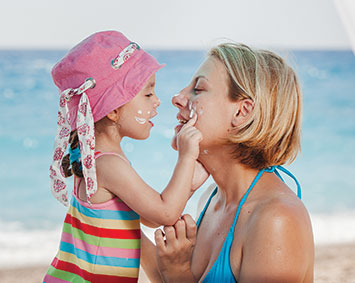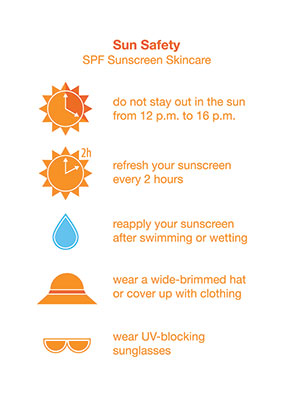Sunscreen even more important now

The Fourth of July weekend is behind us, but it is still sunburn season. The danger of skin cancer certainly hasn’t disappeared during the age of coronavirus, and using sunscreen is more important than ever, experts say. Melanoma, one of the most deadly forms of skin cancer, has been on the rise globally for decades. And while survival rates are getting better, melanoma is still the fifth most commonly diagnosed cancer in the United States.
CHOOSING A SUNSCREEN
Regular daily use of SPF 15 sunscreen can reduce your risk of developing squamous cell carcinoma by about 40 percent and lower your melanoma risk by 50 percent. If you’re inside most of the day with just short intervals in the sun, you can use a sunscreen or cosmetic product with an SPF (sun protection factor) of 15 or higher. If you spend a lot of time outdoors, especially when and where the sun is strongest, you need a water-resistant sunscreen of SPF 30 or higher.

BURNED? DO THIS
It can take several hours for full sun damage to show itself. So at the first sign, get out of the sun and follow this expert advice from the Skin Cancer Foundation.
Here’s a checklist for dealing with bad sunburn, but more importantly, you should not let it happen again. Your risk for melanoma doubles if you’ve had more than five sunburns.
• Act fast to cool it down – If you’re near a cold pool, lake or ocean, take a quick dip to cool your skin, but only for a few seconds so you don’t prolong your exposure. Then cover up and get out of the sun immediately. Continue to cool the burn with cold compresses. You can use ice to make ice water for a cold compress, but don’t apply ice directly to the sunburn. Or take a cool shower or bath, but not for too long, which can be drying, and avoid harsh soap, which might irritate the skin even more.
• Moisturize while skin is damp – Use a gentle moisturizing lotion (but not petroleum or oil-based ointments, which may trap the heat and make the burn worse). Repeat to keep burned or peeling skin moist over the next few days.
• Decrease the inflammation – At the first sign of sunburn, taking a nonsteroidal anti-inflammatory drug (NSAID), such as ibuprofen, naproxen or aspirin, can help with discomfort and inflammation. You can continue with the NSAID as directed until the burn feels better. You can also use a one percent over-the-counter cortisone cream as directed for a few days to help calm redness and swelling. Aloe vera may also soothe mild burns and is generally considered safe. Wear loose, soft, breathable clothing to avoid further skin irritation, and stay out of the sun.
• Replenish your fluids – Burns draw fluid to the skin’s surface and away from the rest of the body, so you may become dehydrated. It’s important to rehydrate by drinking extra liquids, including water and sports drinks that help to replenish electrolytes, immediately and while your skin heals.
• See a doctor – Seek medical help if you or a child has severe blistering over a large portion of the body, has a fever and chills, or is woozy or confused. Don’t scratch or pop blisters, which can lead to infection. Signs of infection include red streaks or oozing pus.
• Bottom line – Your skin will heal, but real damage has been done. Repeat sunburns put you at a substantial risk for skin cancer and premature skin aging. Review the guidelines in The Skin Cancer Foundation’s Prevention Handbook at skincancer.org/prevention/graphics/handbook.



Leave a Reply